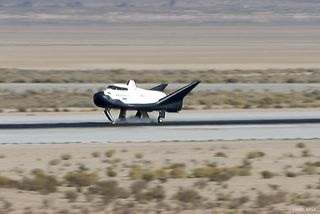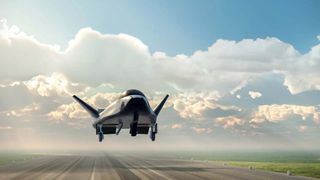Dream Chaser space plane aims to deliver US military cargo within 3 hours
The agreement for point-to-point transportation adds to others Department of Defense want for military and humanitarian purposes.

Dream Chaser is eyeing high-speed shipments for the military through space.
Sierra Space, which is developing the shuttle-shaped Dream Chaser spacecraft for cargo deliveries and potential astronaut flights, signed an agreement with the U.S. Department of Defense (DOD) transportation command for point-to-point space shipments within three hours.
The early-stage cooperative research and development agreement (CRADA) "provides unique capabilities for precise, cost-effective and timely global delivery of [DOD] logistics and personnel," Sierra Space officials said in a Sept. 8 statement.
"Both parties will collaboratively explore space transportation as a new mode of point-to-point global terrestrial delivery of materiel and personnel, as an alternative and complement to traditional air, land and surface modes for … global supply chains," the statement added.
Related: Meet 'Tenacity': 1st Dream Chaser space plane gets a name
The U.S. military has signed several agreements in recent months for future point-to-point transportation needs, including a CRADA with Rocket Lab to use its Electron booster, and a $102 million contract with SpaceX (through the U.S. Air Force) for rocket deliveries of military cargo and humanitarian equipment.
CRADAs allow federal agencies to provide non-funded agreements to private agencies while still offering support through facilities, equipment, expertise and other services. Sierra Space said its agreement would allow the company to create logistics delivery to deal with emergent and high-speed threats in "contested and changing environments" or to supply areas in need of humanitarian relief.
Get the Space.com Newsletter
Breaking space news, the latest updates on rocket launches, skywatching events and more!
The Dream Chaser spacecraft has performed several test flights as Sierra Space targets cargo shipments for NASA (with which it has an agreement for International Space Station resupply missions), along with other entities.
In pictures: Sierra Nevada's Dream Chaser aces glide test flight

The U.S. military has been talking about high-speed space deliveries for at least three years, including overcoming key constraints like weight, volume and restrictions in launch operations and recovery, according to a U.S. Air Force (USAF) release from October 2020.
"As industry advances to overcome these challenges as well as increase its pace of launches to decrease costs, a space transportation capability to put a crucial cargo quickly on target at considerable distances makes it an attractive alternative," USAF officials stated at the time.
Follow Elizabeth Howell on Twitter @howellspace. Follow us on Twitter @Spacedotcom and on Facebook.
Join our Space Forums to keep talking space on the latest missions, night sky and more! And if you have a news tip, correction or comment, let us know at: community@space.com.

Elizabeth Howell (she/her), Ph.D., is a staff writer in the spaceflight channel since 2022 covering diversity, education and gaming as well. She was contributing writer for Space.com for 10 years before joining full-time. Elizabeth's reporting includes multiple exclusives with the White House and Office of the Vice-President of the United States, an exclusive conversation with aspiring space tourist (and NSYNC bassist) Lance Bass, speaking several times with the International Space Station, witnessing five human spaceflight launches on two continents, flying parabolic, working inside a spacesuit, and participating in a simulated Mars mission. Her latest book, "Why Am I Taller?", is co-written with astronaut Dave Williams. Elizabeth holds a Ph.D. and M.Sc. in Space Studies from the University of North Dakota, a Bachelor of Journalism from Canada's Carleton University and a Bachelor of History from Canada's Athabasca University. Elizabeth is also a post-secondary instructor in communications and science at several institutions since 2015; her experience includes developing and teaching an astronomy course at Canada's Algonquin College (with Indigenous content as well) to more than 1,000 students since 2020. Elizabeth first got interested in space after watching the movie Apollo 13 in 1996, and still wants to be an astronaut someday. Mastodon: https://qoto.org/@howellspace
